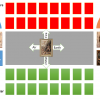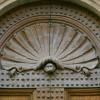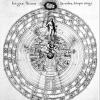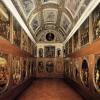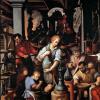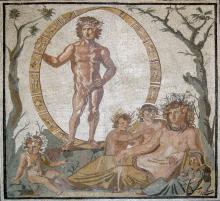
Studiolo of Francesco I: Prometheus and Nature
Commentary
The iconography of Francesco's Studiolo centers on the keystone painting of Prometheus and Nature in the middle of the ceiling. It was rather unusual to depict these two symbols together, although the theme of nature's relationship with art was popular in the era.
Nature
The word 'nature' is drawn on the Latin Natura, itself a translation of the Greek term physis. Physis could mean many things, but in its classical form given by Plato and Aristotle it was an active principle, a purposeful movement. Aristotle in particular contrived the image of physis as both an action and its author, a craft and a craftsman.
In the 1st century BC, Nature started to be viewed as a goddess by conflation with ideas and images of mother earth. The Studiolo's representation of Nature as a seated goddess feeding animals from her breast builds upon portrayals of the Late Antique goddesses Tellus, Cybele and Opis.
Yet presenting Nature as an earth goddess was apparently a Renaissance invention (1470s). As Katharine Park points out,
Nature as a many-breasted or lactating woman was a powerful emblem of fertility and embodied an optimistic view of a benign and bountiful nature [6-7].
Here Nature is clearly depicted as both provider of plenty and a figure friendly to mankind, as she is both nursing a human child at her breast and bestowing gifts to Prometheus. She is also portrayed as a naked and attractive young woman, which makes her desirable to men.
Prometheus
The classical image of Prometheus comes from the play of Aeschylus, Prometheus Bound. In Aeschylus' retelling of the myth, Prometheus is portrayed as a hero who defied Zeus to steal fire for mankind. He also taught human beings all the arts. For his attempt to raise humanity to the level of the gods, Prometheus is punished by being chained to a rock in the Caucasus mountains. He is eventually freed by another hero, Heracles.
Here Prometheus is shown as seated in a cave, holding the fire stalk that he stole from Zeus, which enlightens the entire scene. Like Nature, he is portrayed naked, but also in a sexually suggestive position. The chain that holds him prisoner is shown in the background, but, importantly, Prometheus is not shown as being chained. This may be because Borghini argued that the 'chaining' myth was only a metaphor for Prometheus' dedicated work to mine diamonds and other jewels. Indeed, Prometheus is shown as having produced some polished stones (at his feet). His role as a civilising hero is emphasised by his invention of the wheel; clearly, he is a symbol of 'art' (in the wide sense of craft).
Art-Nature Relationship
Morandini clearly portrays the relationship between Art and Nature as friendly. This again aligns with Borghini's view that Art and Nature 'help one another'. Nature hands over an unformed stone to Prometheus, which may be an unpolished diamond, since Borghini gave the example of the polishing of diamonds as 'Art helping Nature'.
One can argue in fact that Morandini tried to portray the relationship as (borderline) sexual. The genius depicted flying above the two may be Eros, the god of love (even though he is not depicted with his usual bow and arrow). His gesture seems meant to bring the two together. To this may also allude the nakedness, the overt sexuality and the attitude of the two participants. Morandini seems to point to the Renaissance theme of universal love that binds the world, but here it is reinterpreted as love between artisan and nature. However, it is not evident that the relationship is equal; Prometheus sits higher than Nature, and the vertical position looks superior and more active than the sitting Nature.
Controversies surrounding Prometheus
In the foundational source of Greek mythology, Hesiod's Theogony, Prometheus is shown as a dubious trickster who rightfully pays for stealing the fire from the gods. Aeschylus, however, presents him as a civilising hero that saved humanity from the tyranny of the gods.
These opposing views have a long career in Western culture. In the Renaissance, as amongst most Romantic poets, the vision of Prometheus as a heroic character prevailed. However, criticism of Prometheus appears in Mary Shelley's Frankenstein (subtitled 'The Modern Prometheus'), where the Titan is associated with the ambitions of science and technology. The connection with technology and its possibilities is carried on by contemporary thinking. The former Catholic Pope John Paul II warned against the Promethean ambitions of the contemporary science, while William Newman discussed the relationship between art and nature through the less of alchemical thought in his similarly titled Promethean Ambitions (2004). Less neutrally, Pierre Hadot (2006) criticised the 'Promethean' attitude toward nature typical of modern science and technology to the 'Orphic' attitude of philosophy and poetry. In turn, philosopher Günther Anders talked about 'Promethean shame', which is felt by those who consider their organic self as being inferior to the machines they create.
Sources:
Katharine Park, 'Nature in Person: Medieval and Renaissance Allegories and Emblems', in The Moral Authority of Nature, eds. Lorraine Daston and Fernando Vidal (Chicago, 2003).
Valentina Conticelli, 'Prometeo, Natura e il Genio sulla volta dello Stanzino di Francesco I: fonti letterarie, iconografiche e alchemiche', Mitteilungen des Kunsthistorischen Institutes in Florenz, 46: 2/3 (2002), 321-56.
Further Reading:
Pierre Hadot, The Veil of Isis: An Essay on the History of the Idea of Nature, trans. Michael Chase (Cambridge, MA, 2006)
William R. Newman, Promethean Ambitions: Alchemy and the Quest to Perfect Nature (Chicago, 2004)
Günther Anders, 'On Promethean Shame', in Prometheanism: Technology, Digital Culture and Human Obsolescence, ed. and trans. Christopher John Müller (London, 2016), 29-96.
Commentary: Georgiana Hedesan (Feb 2022).

